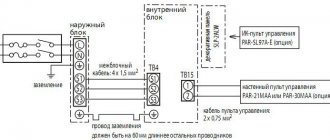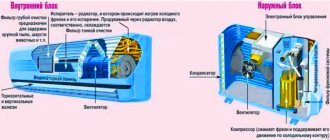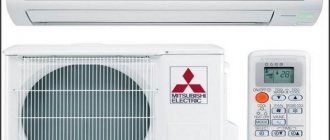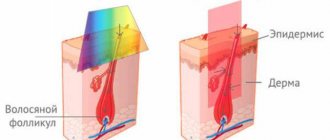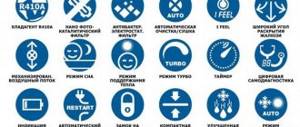To create a pleasant coolness in the house during the warm season, climate control equipment - air conditioners and split systems - is successfully used. The main task of such equipment is to regulate the indoor climate. When choosing equipment for your home or office, it is important to study some of the features of split systems and air conditioners, since these devices have some differences.
In the article we will look at what is important to know about split systems and air conditioners, what are the differences in their design and operating principles, and which device to choose.
What is air conditioner
An air conditioner is a compact climatic device that maintains the optimal air temperature in the room according to a set value. It consists of one block containing a compressor, condenser, evaporator, fan and other important elements responsible for the functionality of the device.
There are two types of household air conditioners:
- Window models placed in the window opening.
- Mobile devices with a special corrugated hose that leads outside. Such devices are usually installed closer to the window. For ease of movement, the air conditioner is equipped with wheels. The kit includes a special tray where condensate is collected.
Operating principle and device
Air conditioners operate from the electrical network on the principle of heat absorption by liquids during evaporation and its release during condensation. The device is equipped with a refrigerant circulating in a closed circle.
What is an air conditioner and its types
An air conditioner in its simplest form is a monoblock with a refrigeration circuit, compressor and fans. Its main task is to cool the indoor air to the desired temperature. Depending on the installation method, window and mobile air conditioners are distinguished. Window ones are mounted in a window opening, and mobile ones do not require special installation, since air circulation is carried out through a corrugation installed in a vent or in a slightly open window; the monoblock can be located on the floor or on a windowsill. Mobile air conditioners are convenient to move from room to room, and also to take with you to the dacha.
Both the first and second types are not highly effective, but have low cost. Modern window air conditioners can not only cool the air, but also mechanically clean it, humidify and heat it. Thanks to their simple design, such devices operate for a long time without maintenance. Among the significant disadvantages, it is worth noting the high noise level, which is directly proportional to the power of the device, and a decrease in illumination in the room. The need to dismantle the air conditioner in the winter makes its operation extremely inconvenient. In addition, in modern plastic double-glazed windows the possibility of installing a window must be provided in advance.
Now let’s look at the operating principle of a split system and find out what its main difference is from an air conditioner.
What is a split system
A split system is a type of air conditioner consisting of two interconnected units. The external unit is installed on the street side. It is equipped with a compressor, condenser and fan.
The indoor unit is installed indoors. This device contains filters, air cooling and heating elements. Two blocks of the split system are connected to each other by heat-insulating copper tubes.
Depending on the installation method, split systems are divided into wall, floor and ceiling models.
Operating principle and device
The operating principle of a split system is identical to the functionality of a conventional air conditioner and is based on artificial air circulation under the action of a compressor and its cooling upon contact with the refrigerant. The outdoor unit removes the products of the indoor module, and the second unit, located indoors, cools and heats the air.
What to choose
The choice depends on the purpose and parameters. In some places, the installation of split systems is impossible due to the law, which does not allow damaging facades by installing external units. People can only use monoblock or portable air conditioners.
It's hard to say which is better, since a lot depends on the manufacturer and the specific model. However, if there are no restrictions, it is recommended to choose a split system.
Subscribe to TechnoCouncil on social networks so you don’t miss anything:
Differences between a split system and an air conditioner
Compared to split systems, air conditioners are simpler designs with a minimal set of functions.
Main differences:
- Condensation from monoblock air conditioners is collected in a special container, from where it is removed manually by the user. In split systems, condensate is discharged to the street through a drainage pipe.
- The design of split systems is more attractive to buyers. This technique is presented in a variety of variations and colors, which allows a person to choose a device for harmonious integration into the interior space. The design of air conditioners is more primitive.
- Split systems operate silently; conventional air conditioners make noise when operating.
- The air conditioner does not have additional functionality that is inherent in modern split systems. For example, air purification, ionization and humidification, removal of unpleasant odors, oxygen saturation mode, air flow adjustment, motion sensor, sleep mode, etc.
And, of course, the main difference between these two types of climate control equipment is the price. Conventional air conditioners are budget equipment; split systems are more expensive, which is fully justified by the expanded functionality of the device.
How to choose an air conditioner for your home: types, parameters
What is the difference between an air conditioner and a split system
Many of us are completely unfamiliar with the concept of a “split system”, so they think that this equipment is significantly different from an air conditioner. Is it really?
Judging superficially, both perform the same role: they regulate the indoor climate by increasing or decreasing the air temperature. However, if you look into the issue in more detail, each person will easily understand the difference.
The concept and principle of operation of an air conditioner
An air conditioner is a climatic device that ensures the maintenance of comfortable climatic conditions and allows you to regulate the air temperature in the room.
The operation of the equipment is carried out on the principle of heat absorption by liquids during evaporation and its release during condensation. The main components that take part in the work include:
- Evaporator;
- Capacitor;
- Fan;
- Compressor;
- A valve that regulates temperature, etc.
First of all, there are two types - household and industrial. Today we are talking about household appliances, so
the industrial version will be discussed in another article.
The variety of air conditioners, according to their structure and features, is as follows:
- Monoblocks;
- Window;
- Split systems;
- Mobile;
- Multisplit systems.
That is, you can already understand that the difference between a split system and an air conditioner is not determined by anything; split is just a variation.
Monoblock devices consist of one block, which serves as a display and ensures the operation of the entire system. The window version is also a monoblock type, however, its operating principle and installation features are significantly different.
Multi-split is a complex of blocks that perform the function of regulating climatic conditions. As a rule, the system consists of one outdoor unit and several internal parts.
Mobile devices are mobile devices that are used mainly for events, corporate events, conferences, etc. The operating principle of this device is significantly different from others, and the technical characteristics, especially power, are inferior to the classic versions.
A useful article about which air conditioner is better - inverter or classic.
The concept and principle of operation of a split system
A split system is a climate control system that consists of two main parts that perform the work -
indoor and outdoor units. There is a highway for their interaction. It consists of tubes through which fluid moves and cables that provide the movement of electricity.
The principle of operation of a split system, as a type of air conditioner, is as follows: the compressor compresses freon to 20 atmospheres, as a result of which liquid freon exits the condenser into the expansion valve, where the atmosphere decreases along with the temperature. As a final result, freon enters the evaporator, where it turns into a gaseous state and is blown with air, taking away its heat and giving it cold.
The outdoor unit contains the following elements:
- Compressor;
- Capacitor;
- Fan.
The evaporator is located in the indoor unit, allowing the freon to be blown by air from the room and cooled.
Split system or air conditioner: which is better to choose?
The choice of climate control equipment is determined taking into account the specific conditions, capabilities and wishes of the buyer. If you have limited funds to purchase equipment, you can choose a regular window air conditioner with standard functionality.
Mobile air conditioners are an excellent choice for people living in rented apartments. Such devices can be installed anywhere, they do not need to be dismantled, and to move, you just need to disconnect the corrugated hose.
Split systems are suitable for installation in apartments, country houses, offices and other public institutions. If opportunities permit, you can buy a multifunctional device that will not only create pleasant coolness during the hot season, but also perform other functions beneficial to the human body. In addition, such models aesthetically fit into the interior of the room.
The choice of climate control equipment is quite large. Each buyer will choose a device to suit his taste and budget.
Differences between split systems and air conditioners
During the installation of climate control equipment, additional differences between a split system and an air conditioner are identified. In addition to power, design and design also differ. The varieties of air conditioner models available today provide installation of equipment that looks like a picture. Also today, the color palette of air conditioners is significant and varied - the color will match the design of the room.
Thus, it should be summarized that an air conditioner together with a split system is still one option for climate control equipment if air conditioning of a living space is necessary. If this is an industrial facility or production facility with a significant area, preference is given to powerful models of climate control equipment. They have higher efficiency in heating or cooling a room. The difference lies in the installation and operating principle. Specialists and professionals in their field will be able to dispel any doubts; they will be able to select the right model, taking into account the area and use of the room.
We carry out repairs of split systems in Volgograd at home.
Call: 8(8442) 50-50-06, 8-902-310-00-48. Let's help!
Master visits and diagnostics are free!
The operating principle of cooling equipment and its composition
Despite the fact that in the understanding of many people, an air conditioner is a device for cooling air, this is not entirely true. The air conditioner is designed to control both temperature and relative humidity. It was for these purposes that it was developed more than 100 years ago.
The first air conditioner was developed in 1902 to combat humidity in printing plants. The idea belonged to the American engineer Willis Carrier, after whom one of the most famous companies in the development of climate control technology, Carrier, is named. The first air conditioner worked on the same principle as a modern split system, the only difference was in size.
To understand how the systems work and how they differ, let’s look at their simplified design. A modern air cooling device consists of the following elements:
- Compressor;
- Capacitor;
- Thermostatic valve;
- Evaporator;
- Additional devices: fans and temperature sensors.
To operate an air conditioner, you need a refrigerant - a substance that is in a sealed circuit and undergoes evaporation and condensation processes. Now specially developed freons are used for these purposes, which is better than the ammonia used previously.
We recommend that you read: The principle of operation of an air conditioner: how to turn on the device for heating
The cooling device operates as follows:
- Freon under normal atmospheric conditions is in a gaseous state. In this form, it is also located in the circuit of a non-working system.
- After turning on the device, the compressor starts working, compressing the freon to high pressures.
- The high-pressure gas moves into the condenser, where it condenses and releases heat into the surrounding atmosphere.
- Freon in a liquid state moves towards the evaporator. After passing through the thermostatic valve, evaporation occurs. During evaporation, freon absorbs heat.
- The gas moves to the compressor and the cycle is completed.
This is the principle of operation of an air conditioner. Below we will look at the difference between a split system and an air conditioner.
Classification of air conditioners
Considering this issue in more detail, it is impossible not to mention that air conditioners mean all climate control equipment designed to cool a room and operating according to a certain principle. All such equipment is divided into several categories:
- Split systems;
- Monoblocks (window);
- Mobile devices.
Since they are all air conditioners, it is advisable to consider the differences between an air conditioner and a split system in comparison with other listed analogues. All of them differ, as a rule, in their operating principle, installation method, and power characteristics. The latter indicator can vary significantly depending on the model purchased.
What types of air conditioners are there?
Household monoblock air conditioners come in two types – window and mobile.
Window
They are usually installed in a window opening, but can also be installed in a wall if it is thin enough. The main advantage of a window air conditioner is its low cost. In the case of an ordinary wooden window, one can also note the ease of installation, but if metal-plastic windows with double-glazed windows are installed, the installation will be fraught with some difficulties.
Window air conditioner
In addition to noise, there are the following disadvantages:
- the glazing area is reduced, and with it the intensity of natural light;
- there is no possibility to close the window with a curtain;
In addition, in winter, the air conditioner, acting as a cold bridge, contributes to heat leaks.
Mobile
This air conditioner stands on the floor like a nightstand. Thanks to the chassis, it can easily be moved to any office or apartment. To discharge hot air, a corrugated pipe is connected to the air conditioner, the other end of which must be led outside through a window or an opening in the wall.
The advantages of this device are as follows:
- mobility;
- no installation is required, however, if there is no window, you will have to punch a hole in the wall.
But here are the disadvantages you will have to put up with (besides the noise already mentioned):
- cost - at the level of a split system or even higher;
- unaesthetic appearance: the corrugated air duct does not decorate the interior in any way;
- takes up space on the floor;
The mobile air conditioner cannot operate in room heating mode.
Window monoblock
A window air conditioner, or all-in-one air conditioner, is one of the most common categories of cooling devices. This is due to a number of advantages, ranging from ease of installation and use to good efficiency. As the name suggests, this unit is mounted directly into the window and, by sucking in air from the street, cools it.
Despite all the advantages, the window option has a number of disadvantages. Compared to a split system, it is noticeably less powerful and also reduces the level of illumination in the room. In addition, the peculiarity of the installation makes its use extremely inconvenient in cases where the windows of the room do not open upward, but outward.
This is interesting! Which air purifier-humidifier to choose for your apartment?
This option is most often used in public and private institutions, since in case of a move, it can be easily dismantled and transported to a new location . For use in residential premises, such a unit is not well suited .
Other differences
The operating principle of a split system suggests that it is permissible to install the air conditioner in a variety of places in the room.
This significantly expands the capabilities of the end user and allows you to plan the interior of the room without significant restrictions. Depending on the type of split system, they can be installed on the wall, on the ceiling or even on the floor. This distinguishes such units from a number of analogues that have installation restrictions. Another fundamental difference seems to be condensate drainage. Window and mobile devices require periodic drainage of accumulated condensate manually, which somewhat complicates the use of the devices. Split systems remove condensate automatically and do not require such actions from the user for correct operation.
This is interesting! Air washing reviews about the benefits and harms of the device
Thus, it is impossible to say which is better - air conditioners or split systems , since the latter unit is only one of the varieties of these cooling devices.
Split systems and air conditioners

